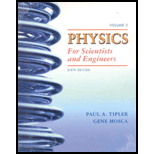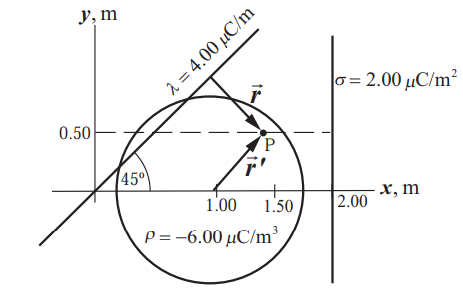
Concept explainers
The magnitude and the direction of the electric field in the z plane at
The electric field at point P is
Given:

The charges are placed as shown in the figure. The first plane at
The charge densities are
Formula Used:
Electric field
E is the electric field.
The resultant electric field at point is
Calculations:
The resultant electric field at point is
Electric field at point P due to sphere.
From the figure
Substituting the values
Electric field at point P due to plane 1
Substituting values in the formula
The electric field at point P due to line charge.
From the figure
Substituting the values
Substituting in the equation
The resultant electric field at point is
The magnitude of the electric field is
Conclusion:
The electric field
Answer to Problem 78P
The electric field at point P is
Explanation of Solution
Given:

The charges are placed as shown in the figure. The first plane at
The charge densities are
Formula Used:
Electric field
E is the electric field.
The resultant electric field at point is
Calculations:
The resultant electric field at point is
Electric field at point P due to sphere.
From the figure
Substituting the values
Electric field at point P due to plane 1
Substituting values in the formula
The electric field at point P due to line charge.
From the figure
Substituting the values
Substituting in the equation
The resultant electric field at point is
The magnitude of the electric field is
Conclusion:
The electric field
Want to see more full solutions like this?
Chapter 22 Solutions
Physics for Scientists and Engineers, Vol. 3
- A charge of uniform linear density 2.80 nC/m is distributed along a long, thin, nonconducting rod. The rod is coaxial with a long conducting cylindrical shell (inner radius = 5.20 cm, outer radius = 10.6 cm). The net charge on the shell is zero. (a) What is the magnitude of the electric field at distance r = 15.8 cm from the axis of the shell? What is the surface charge density on the (b) inner and (c) outer surface of the shell? Please Helparrow_forwardA spherical Conductor of radius 0.330 m has a spherical cavity of radius 0.120m at its center. The conductor carries a total charge of -6.00 nC; in addition, at the center of the spherical cavity is a point charge of +4.00 nC. Find (a) the total charge on the surface of the cavity, (b) the total charge on the outer surface of the condutor, (c) the magnitude of the electric field just inside te surface of the cavity, and (d) the magnitude of the electric field just outside the outer surface of the conductor.arrow_forwardA long, thin wire carrying uniform line charge density λ1 runs down the center of a long cylindrical tube of radius 15.0 cm carrying charge distributed uniformly over its surface; the charge per unit length of the tube is λ2. The electric field 7.50 cm from the center of the wire has magnitude 1.17 MN/C and points inward. The electric field 23.8 cm from the center of the wire has magnitude 3.68 MN/C and points outward. Find the line charge density λ1 on the wire, and the line charge density λ2 on the tube.arrow_forward
- A solid nonconducting sphere of radius R carries a charge Q distributed uniformly throughout its volume. At a certain distance r1 (r1 < R) from the center of the sphere, the electric field has magnitude E. If the same charge Q were distributed uniformly throughout a sphere of radius 2R, the magnitude of the electric field at the same distance r1 from the center would be equal to a) E. b) 2E. c) E/2. d) E/8. e) 8E.arrow_forwardA sphere of radius 2m is made of a non-conducting material that has a uniformvolume charge density ρ = 2.655 × 10−10C/m3. A spherical cavity of radius 1m isthen carved out from the sphere. As measured from the center of the large sphere,the center of the spherical cavity is at the position ~r = cos300ˆi + sin300ˆj.Find the electric field at a point P within the cavity. As measured from the centerof the cavity, the point P is at the position ~r′ = 0.5cos600ˆi + 0.5sin600ˆj.1arrow_forwardA spherical Conductor of radius 0.330 m has a spherical cavity of radius 0.120m at its center. The conductor carries a total charge of -6.00 nC; in addition, at the center of the spherical cavity is a point charge of +4.00 nC. Find (a) the total charge on the surface of the cavity, (b) the total charge on the outer surface of the condutor, (c) the magnitude of the electric field just inside te surface of the cavity, and The answers were wrong on the previous attempts, the answers should be (a) +4.00 nC (b) -4.00 nC (c) 2.5*10^3 N/C I need to know how those answers are solvedarrow_forward
- A very long uniform line of charge with charge per unit length λ = +5.00 μC/m lies along the xx-axis, with its midpoint at the origin. A very large uniform sheet of charge is parallel to the xy-plane; the center of the sheet is at z = +0.600 m. The sheet has charge per unit area σ = +8.00 μC/m2, and the center of the sheet is at x=0, y=0. Point A is on the z-axis at z = +0.300 m, and point B is on the z-axis at z = -0.200 m.What is the potential difference VAB=VA−VB between points A and B?arrow_forwardA solid non-conducting sphere of radius R carries a uniform charge density. At a radial distance r 1 = 6R the electric field has a magnitude E 0. What is the magnitude of the electric field at a radial distance r 2 = R/6 as a multiple of E 0 ?arrow_forwardA non-conducting solid sphere withvolumetric charge density pa and radiusa , is surrounded by a conducting spherical shellconducting spherical shell of inner radius a andouter radius b with bulk charge densitycharge density pb . Find the expressionfor the magnitude of the electric field for: (a) points inside the central nonconducting central sphere. b) Points outside the central non-conducting sphere and inside the shell.and inside the spherical shell.spherical shell. c) Points outside both cylinders.arrow_forward
- A solid conducting sphere of radius 2.00 cm has a charge 8.00 μC. A conducting spherical shell of inner radius 4.00 cm and outer radius 5.00 cm is concentric with the solid sphere and has a total charge −4.00 μC. Find the electric field at (a) r = 1.00 cm, (b) r = 3.00 cm, (c) r = 4.50 cm, and (d) r = 7.00 cm from the center of this charge configuration.arrow_forwardA long, straight wire is surrounded by a hollow metal cylinder whose axis coincides with that of the wire. The wire has a charge per unit length of , and the cylinder has a net charge per unit length of 2. From this information, use Gausss law to find (a) the charge per unit length on the inner surface of the cylinder, (b) the charge per unit length on the outer surface of the cylinder, and (c) the electric field outside the cylinder a distance r from the axis.arrow_forwardIn Figure 2, a sphere of radius r = 0.42 m carries a uniform volume charge density of rho = 2.3 × 10^-10 C/m^2. A spherical cavity of radius 0.21 m is then cut out and left empty as shown in the figure. Points A and C are the centers of the sphere and the spherical cavity, respectively. Find the magnitude and direction of the electric field at point B.arrow_forward
 Principles of Physics: A Calculus-Based TextPhysicsISBN:9781133104261Author:Raymond A. Serway, John W. JewettPublisher:Cengage Learning
Principles of Physics: A Calculus-Based TextPhysicsISBN:9781133104261Author:Raymond A. Serway, John W. JewettPublisher:Cengage Learning Physics for Scientists and Engineers: Foundations...PhysicsISBN:9781133939146Author:Katz, Debora M.Publisher:Cengage Learning
Physics for Scientists and Engineers: Foundations...PhysicsISBN:9781133939146Author:Katz, Debora M.Publisher:Cengage Learning

